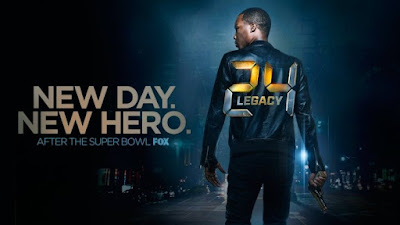If pop psychology, safari-suited hipsters and mind-swapping is your thing, Marvel's Legion is the show for you.
 |
| We've all felt like this from time to time. (Image copyright: 26 Keys Productions). |
It’s not that often a TV series comes along that you feel
compelled to praise very loudly from the rooftops, grab people by the lapels
and enthuse wildly to, or go online and clog up social media with
superlatives. Legion, the latest offering from the Marvel TV stable, is one
such glittering example.
The thing is, you wouldn’t know it was a Marvel
series. It’s one of the most stylised, surreal, psychologically playful and
insightful, not to mention just plain stylish, series ever to have graced the
small screen. That’s because Legion’s
visuals are filtered through the unreliable worldview of David Haller (Downton Abbey’s Dan Stevens, playing
very convincingly with an American accent and attitude), a schizophrenic we
first meet in a mental hospital. He’s been struggling with mental illness all
his life, so by the time he reaches his thirties and has been sectioned, he’s
not sure if anything that happens to him is, in fact, real. (This uncertainty
in his perceptions leads to a corker of a cliffhanger at the end of episode
four).
You’d never know Legion
is a spin-off from the X-Men comics,
in much the same way you be hard pressed to say Patrick McGoohan’s personal tour de force The Prisoner (1967-68) was basically a spy series. Legion’s Wikipedia entry describes the
series as ‘psychological thriller/psychological horror/drama/superhero fiction’,
which is another way of saying that, like The
Prisoner, Legion is a gleeful, freewheeling mixture of, and breaking down
of, different genres.
It really is like nothing you’ve ever seen before. The
super hero angle – Haller’s schizophrenia is really a major superpower, incorporating
telepathy and telekinesis, that a group led by psychiatric therapist Melanie
Bird (Jean Smart, oozing authority) wants to develop and a rival, paramilitary
group want to destroy – is filtered through David’s attempts to work out who he really
is after years of mental illness and drug addiction.
The paranormal talents of Smart’s group complement Haller’s distorted worldview: Ptonomy Wallace (Jeremie Harris), who has “the ability to take people back into their own memories”; Carey Loudermilk (Bill Irwin), a mutant scientist who shares his body with the martial-arts expert Kerry Loudermilk (the improbably named Amber Midthunder), and Sydney ‘Syd’ Barrett (angelic Rachel Keller, and no, the name of her character isn’t a coincidence), who can swap minds with anyone she touches. As well as all these, Dan is plagued by a questioning part of his psyche that appears in the form of his deceased drug and alcohol-addled friend Lenny Busker (Aubrey Plaza), killed in the first episode.
The paranormal talents of Smart’s group complement Haller’s distorted worldview: Ptonomy Wallace (Jeremie Harris), who has “the ability to take people back into their own memories”; Carey Loudermilk (Bill Irwin), a mutant scientist who shares his body with the martial-arts expert Kerry Loudermilk (the improbably named Amber Midthunder), and Sydney ‘Syd’ Barrett (angelic Rachel Keller, and no, the name of her character isn’t a coincidence), who can swap minds with anyone she touches. As well as all these, Dan is plagued by a questioning part of his psyche that appears in the form of his deceased drug and alcohol-addled friend Lenny Busker (Aubrey Plaza), killed in the first episode.
Such an off-kilter array of characters and abilities
creates opportunities for fantasy and surrealism such as a kitchen erupting its
contents in a slow-motion storm around Dan, a groovy, synchronised dance number
performed by assorted mental patients and Oliver Bird, Melanie’s comatose husband
(Jemaine Clement, late of Flight of the
Conchords) a hipster in a safari suit whose mind now lives inside an ice
cube, where he grooves along to avant
garde music.
This may all sound like a huge mess, but the narrative
through-line is always clear so the series never collapses into
self-indulgence. It’s a great achievement, a story told wittily and
comprehensibly through dream imagery and multiple versions of reality; apart
from that, Legion is just plain cool,
the performances are a joy and it makes you laugh out loud more than once.
The series is a testament to how comfortable
television networks now are with this kind byzantine storytelling. It’s certainly
a long way from the days when, in comparison, a mildly surrealistic experiment like
The Prisoner confused everyone.
Recommended.


